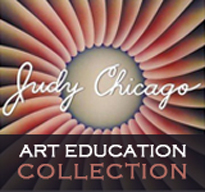Judy Chicago & Donald Woodman’s content-based critique involves discussion with each artist while looking at material samples, sketches, and models of developing ideas.
Judy Chicago describes that the problem for the artist is to create something that is a clear vision. Key components of a content-based critique to assist the artist to form a clear vision in the artwork involves discussion of the following:
1. What is your goal with this piece?
2. Start by telling me what you want to express.
3. Let’s talk about ways you could do this.
4. How will the viewer understand it?
Judy asked one participant, “what is the meaning of the background?” Everything in the artwork should be part of the meaning of the work in relation to the project theme. The meaning should be accessible, yet not simplified, to be understood by others.
Content-based critiques occur in the time between arriving at a concept and starting to formulate the media, work mode, and format in the early stages of production. When the time to complete the work is near, and all are far into a specific direction with their work, the facilitator’s role changes to provide suggestions such as “maybe this will work better than that” or “how about trying such and such” rather than the content-based critique questions posed earlier in the artmaking process.
Susan Krieg, the painting facilitator in the ETF project, notes that Judy can pull participants very quickly out of old habits concerning which visuals are working or not to convey the intent.
Video: For installation art they look at the placement of the art within a miniature model of the exhibition space and discuss the proposed work while standing in the actual space.

Leave a Reply
You must be logged in to post a comment.